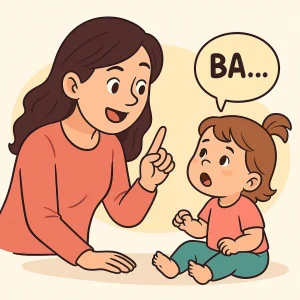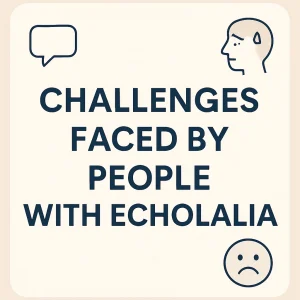6 Varieties of Lisps and How to Overcome Them
By Rajini D
Last Updated: March 18, 2024
Welcome to a journey into how we make sounds in speech. It’s a world where every letter and every word is important for talking and connecting with others. One common speech challenge that many people face is lisps. Lisps changes how “s” and “z” sounds are made, making them unique. They’re not just a way of speaking; they show us how diverse human speech and learning can be. Surprisingly, about 23% of people who go to speech therapists have a lisp. This shows us how common they are and why it’s important to work on them. Getting better at making these sounds can really help someone speak more clearly and feel more confident.
For more insights into how speech disorders can impact daily life, consider exploring our comprehensive guide to speech and language milestones.
Understanding Lisps
What is a Lisp? A Simple Explanation
A lisp is when someone doesn’t say “s” and “z” sounds the right way. Instead of sounding sharp and clear, these sounds might come out more like “th,” or the air might not flow as it should, changing how the sounds come out. This small mix-up can make it harder for people to speak clearly, and it might worry them and their families. Speech therapy for lisps helps people say these sounds better, which makes it easier for them to talk clearly and feel more confident.
Causes of Lisps: Delving into the Whys
Understanding the root causes of lisps is crucial in addressing them effectively. While the exact cause can vary from person to person, several common factors often play a role:
- Developmental Variations: Some children develop lisps as part of their natural speech and language development. In many cases, these lisps resolve on their own as children’s speech patterns mature.
- Anatomical Factors: Sometimes, a lisp can happen because of physical reasons. For example, if someone has a tongue-tie (ankyloglossia), their tongue can’t move freely.
- Neurological or Physical Conditions: Certain medical conditions, including cerebral palsy or a stroke, can affect the muscles and nerves responsible for speech, leading to a lisp.
- Habits: Prolonged use of a pacifier or bottle, thumb sucking, or other oral habits can influence tongue position and muscle development, potentially leading to a lisp.
- Learned Speech Patterns: Sometimes, a lisp can develop simply from imitating others or not learning the correct tongue placement for “s” and “z” sounds.
The 6 Varieties of Lisps
Navigating the world of lisps reveals a fascinating diversity, each with its unique challenges and solutions. Understanding these varieties is the first step toward effective communication. Let’s explore the six main types of lisps that individuals may encounter.
1. Interdental Lisp (Frontal Lisp):
Imagine trying to say the word “sun,” but instead of a clear “s” sound, it comes out as “thun.” This happens when the tongue protrudes between the front teeth during speech, altering the sound of “s” and “z” into something more like “th.” It’s like the tongue is a little too eager, reaching out when it should be staying back.
2. Dentalized Lisp:
In this case, the tongue doesn’t venture as far forward as with the interdental lisp but still makes contact with the front teeth, pushing against them. This pressure changes the way air flows out of the mouth when forming “s” and “z” sounds, leading to a slightly muffled version of these sounds. It’s a subtle difference but one that can affect clarity.
3. Lateral Lisp:
Here, the air doesn’t follow its usual path out the front of the mouth. Instead, it escapes over the sides of the tongue, giving speech a “slushy” quality. This type of lisp can make “s” and “z” sounds seem overly wet or muddy as if spoken with a mouthful of water.
4. Palatal Lisp:
This occurs when the middle or back of the tongue touches the soft palate (or roof of the mouth) far back instead of the alveolar ridge just behind the upper front teeth. The result is a sound that can seem more like a “sh” than a clear “s.”
5. Developmental Lisp:
Commonly seen in children, this lisp is part of the natural learning curve as they master the sounds of their language. Most children outgrow it without intervention, but some may need a little extra help to fine-tune their pronunciation.
6. Functional Lisp:
Sometimes, a lisp isn’t just about physical speech mechanics but is linked to psychological factors such as stress or anxiety. This type of lisp can emerge in adults or children and may require a holistic approach to address both the emotional and physical aspects of speech.
Also read: Speech Sound Disorders: Causes, Treatment and Strategies
Types of Lips
| Type of Lisp | Sound Affected | Description |
|---|---|---|
| Interdental Lisp | “S” and “Z” | This type of lisp occurs when the tongue extends too far forward, protruding between the front teeth when attempting to produce “s” or “z” sounds, resulting in these sounds being replaced with a “th” sound. Commonly seen in children, but can persist into adulthood without intervention. |
| Dentalized Lisp | “S” and “Z” | Characterized by the tongue pushing against the back of the upper front teeth rather than protruding between them, affecting the clarity of “s” and “z” sounds and making them sound muffled or dampened. |
| Lateral Lisp | “S” and “Z” | In a lateral lisp, the airflow is directed over the sides of the tongue instead of directly forward, leading to a slushy-sounding “s” and “z” due to excessive air escape, often described as having a “wet” or “slushy” quality to it. |
| Palatal Lisp | “S” and “Z” | This less common lisp involves the middle or back of the tongue making contact with the soft palate, or roof of the mouth, when attempting “s” and “z” sounds, often causing these sounds to be produced with a “sh” quality. |
| Developmental Lisp | “S” and “Z” | Often considered a part of the normal speech development process in young children, this lisp is typified by incorrect formation of “s” and “z” sounds, which is generally outgrown as speech matures. However, some cases may require intervention if persistence is noted beyond the typical age range. |
| Functional Lisp | “S” and “Z” | Stemming from no apparent physical cause, this lisp is thought to be related to habits, psychological factors, or imitative behaviors. It is marked by difficulty in producing “s” and “z” sounds correctly, often influenced by stress or anxiety levels in adults or older children. |
Our tips on how to talk confidently when you stutter in public can offer additional support.
At Wellness Hub, we understand that the journey to clear speech is deeply personal and can be fraught with frustration and setbacks. That’s why we’re committed to providing resources, support, and guidance to help individuals of all ages find their voice and speak confidently. Remember, identifying the type of lisp is the first step toward effective intervention and, ultimately, clearer communication.
How to Overcome Lisps
Overcoming a lisp is a journey of patience, practice, and, sometimes, professional guidance. Let’s explore some of the ways to address this common speech impediment, keeping in mind the goal is clear, confident communication.
Speech Therapy Techniques
Speech therapy offers a treasure trove of techniques specifically designed to correct lisps. These are tailored to the individual’s needs, taking into account the type of lisp and the person’s age, among other factors. Some effective methods include:
- Articulation Therapy: This involves exercises to help correctly position the tongue when producing “s” and “z” sounds, focusing on the precise movement needed to produce these sounds accurately.
- Phonological Awareness: Enhancing the understanding of sounds in words can be particularly useful, especially for children. This might involve games and activities that focus on identifying and manipulating sounds.
- Visual and Auditory Feedback: Using mirrors during practice or recording and playing back speech can provide immediate feedback, helping to adjust tongue placement and sound production in real-time.
Know more: Understanding Speech Chain: Key to Better Communication
Speech Therapy Vs. At-Home Exercises
| Method | Description | Examples |
|---|---|---|
| Speech Therapy | Professional guidance involves working with a speech-language pathologist (SLP) who assesses and diagnoses speech impediments and then designs a personalized therapy plan. This method leverages the therapist’s expertise to target specific speech issues with tailored exercises, ensuring progress is closely monitored and adjusted as needed. | – Mirror Exercises: Engaging in practice while watching oneself in the mirror to improve awareness of mouth, tongue, and jaw movements. – Phoneme Practice: Focused exercises on specific sounds or phonemes that are challenging for the individual, often incorporating repetitive pronunciation and articulation activities. |
| At-Home Exercises | Simple practices that individuals can do on their own or with family members to support and enhance speech clarity. These exercises are meant to complement professional therapy by reinforcing learned techniques and promoting consistent practice. They are generally less tailored but can still significantly impact speech improvement. | – Reading Aloud: Selecting books or passages to read out loud, focusing on articulation and clarity of speech, particularly with sounds that are difficult for the individual. – Using Props for Tongue Placement: Implementing household items or specialized tools to assist in correct tongue placement for challenging sounds, such as using a popsicle stick to guide tongue position. |
Learn more: 7 Easy Home Exercises for Frontal Lisp
At-Home Practices
In addition to professional speech therapy, there are exercises you can do at home to further progress. Engagement in daily practice can significantly enhance the effectiveness of speech therapy. Here are a few simple exercises:
- The Butterfly Exercise: Place the tip of your tongue behind your upper front teeth without touching them. Try to produce the “s” sound while keeping your tongue in place. This helps in reducing interdental lisping.
- Reading Aloud: Spend time each day reading aloud from a book or magazine. Focus on enunciating “s” and “z” sounds clear. This not only improves articulation but also builds confidence in speaking.
- Blowing Exercises: Doing things like blowing bubbles or using a straw can help make the muscles used in talking stronger. This can make it easier to manage how the air moves and where the tongue goes when speaking.
Learn more: Oral motor Exercises: Key to Better Speech
Conclusion
As we finish learning about the six types of lisps, it’s important to see how special this journey has been. It’s not just about knowing what lisps are; it’s about making our voices stronger and talking better. Beating a lisp has its ups and downs, but it shows how tough and eager we are to get better. The journey might look hard, but every little step takes us closer to speaking more clearly and confidently. It’s not about being perfect right away but about getting better step by step, even when it’s tough.
Wellness Hub is here to help you speak better. We’re all about giving you the best support and care and helping you find the right ways to get past speech problems. Your journey is your own, and your voice matters. Taking steps to speak more clearly is a big deal, and it’s something to be proud of. Remember, you’re not doing this alone. Together, we can reach the goal of speaking confidently and clearly, making every word important.
Frequently Asked Questions:
1. What is a lisp?
A lisp is a speech disorder that affects how a person produces the sounds “s” and “z.” People who lisp may whistle or slur these sounds.
2. How many types of lisps are there?
Lisps are more varied than many realize, with six main varieties identified in speech therapy practices. These include:
- Interdental (Frontal) Lisp: The tongue protrudes between the front teeth.
- Dentalized Lisp: The tongue pushes against the front teeth.
- Lateral Lisp: Air escapes over the sides of the tongue.
- Palatal Lisp: The tongue touches the roof of the mouth.
- Developmental Lisp: Often seen in children; usually outgrown.
- Functional Lisp: This can be related to stress or anxiety. Each type has its unique challenges and solutions, making identification the first step toward effective treatment.
3. Can lisps be corrected?
The good news is that most lisps can be corrected with the right approach, which usually involves speech therapy. Speech therapists employ a variety of techniques tailored to the specific type of lisp an individual has. These methods focus on teaching correct tongue placement, breath control, and muscle use for speech. Consistency in practice and a patient, persistent attitude are crucial components of the process.
4. Are there exercises I can do at home to help with a lisp?
Absolutely! Engaging in simple, at-home exercises can significantly support the correction of a lisp. Activities such as practicing the correct placement of the tongue for “s” and “z” sounds, reading aloud to focus on articulation, and using a mirror to observe and adjust tongue movements can all be beneficial. These exercises serve as valuable complements to structured speech therapy sessions.
5. When should I seek professional help for a lisp?
Seeking professional help is advisable if a lisp persists beyond the early developmental stages of childhood or begins to significantly impact an individual’s ability to communicate effectively and confidently. Speech therapists can conduct comprehensive evaluations to identify the type of lisp and create personalized treatment plans that cater to individual needs and goals.
6. How can Wellness Hub help with overcoming a lisp?
At Wellness Hub, we are dedicated to supporting individuals on their journey to clearer speech. Our resources and access to qualified speech therapists ensure that you or your loved one can find the help needed to overcome a lisp. Our approach prioritizes accessible, empathetic care, focusing on empowering our clients through personalized support and effective speech therapy techniques.
7. Do lisps affect adults as well as children?
Lisps are commonly associated with children, but adults can experience them too. In adults, lisps might persist from childhood due to a lack of treatment, or they can develop as a result of neurological conditions, stress, or trauma. Regardless of age, treatment options are available that cater to the unique circumstances of each individual, highlighting that it’s never too late to seek improvement and gain confidence in one’s speech.
8. Is it possible to outgrow a lisp without treatment?
While some children may naturally outgrow developmental lisps as their speech and language skills mature, not all types of lisps will resolve without intervention. Persistent lisps, especially those not classified as developmental, typically require speech therapy for improvement.
9. What role does anxiety play in functional lisps?
Anxiety can contribute to the development or exacerbation of functional lisps by affecting speech patterns and muscle tension. Individuals experiencing high levels of stress or anxiety may find that their lisp becomes more pronounced during stressful situations. Addressing underlying anxiety with therapeutic support, alongside speech therapy, can be beneficial in these cases.
10. Can incorrect dental alignment cause a lisp?
Yes, incorrect dental alignment, such as malocclusion (where the upper and lower teeth do not align properly), can contribute to the development of certain types of lisps, like dentalized or interdental lisps. In such cases, orthodontic treatment may be recommended alongside speech therapy to address both the alignment and speech issues.
About the Author:
Rajini Darugupally
M.Sc., Speech-Language Pathologist (9+ years of experience)
Rajini is a passionate and dedicated Speech-Language Pathologist with over 9+ years of experience, specializing in both developmental speech and language disorders in children and rehabilitation in adults. Driven by a desire to empower each individual to find their voice, Rajini brings a wealth of experience and a warm, genuine approach to therapy.
Currently, at Wellness Hub, she thrives in a team environment that values innovation, compassion, and achieving results for their clients.
Connect with Rajini to learn more about how she can help you or your loved one find their voice.
Book your Free Consultation Today
Parent/Caregiver Info:
Client’s Details:
* Error Message









